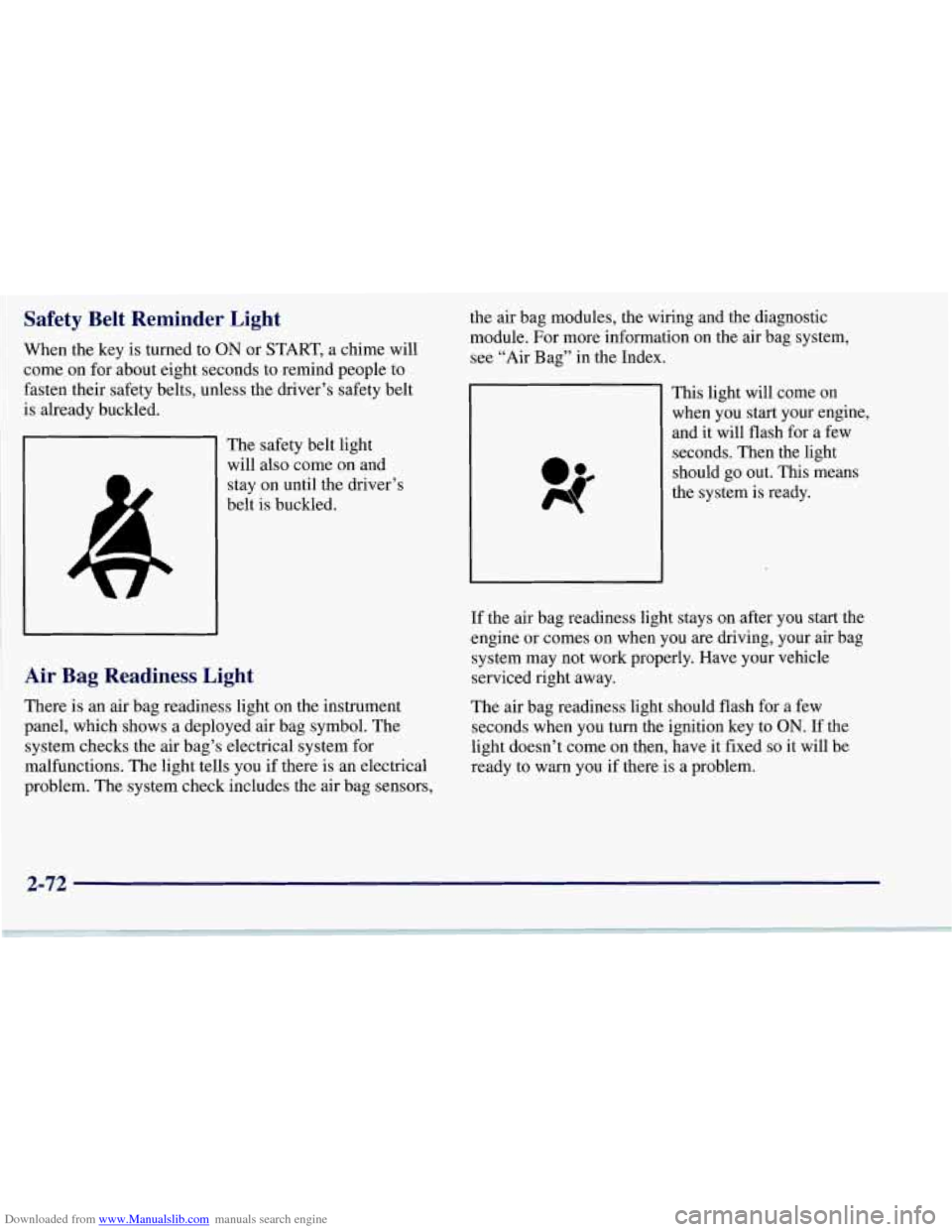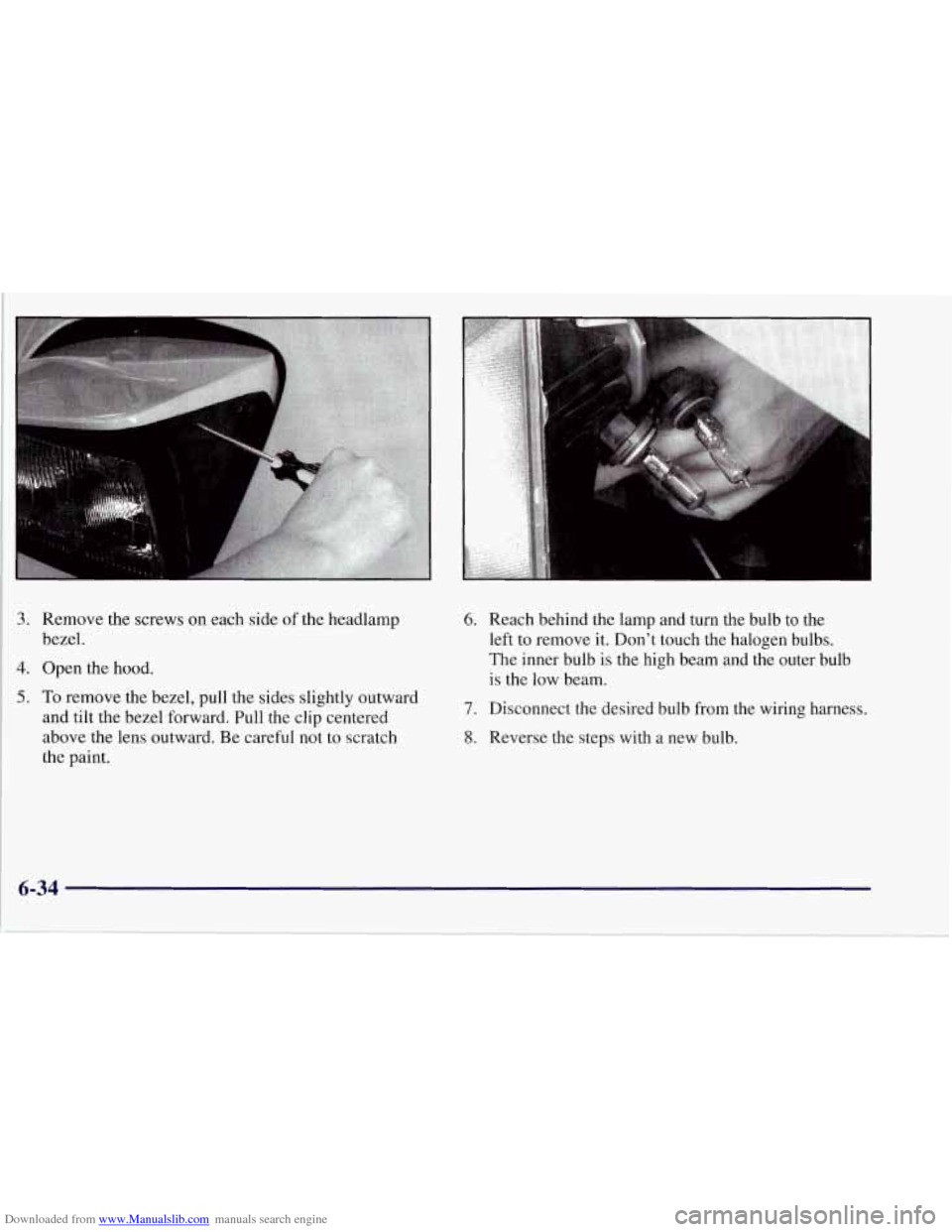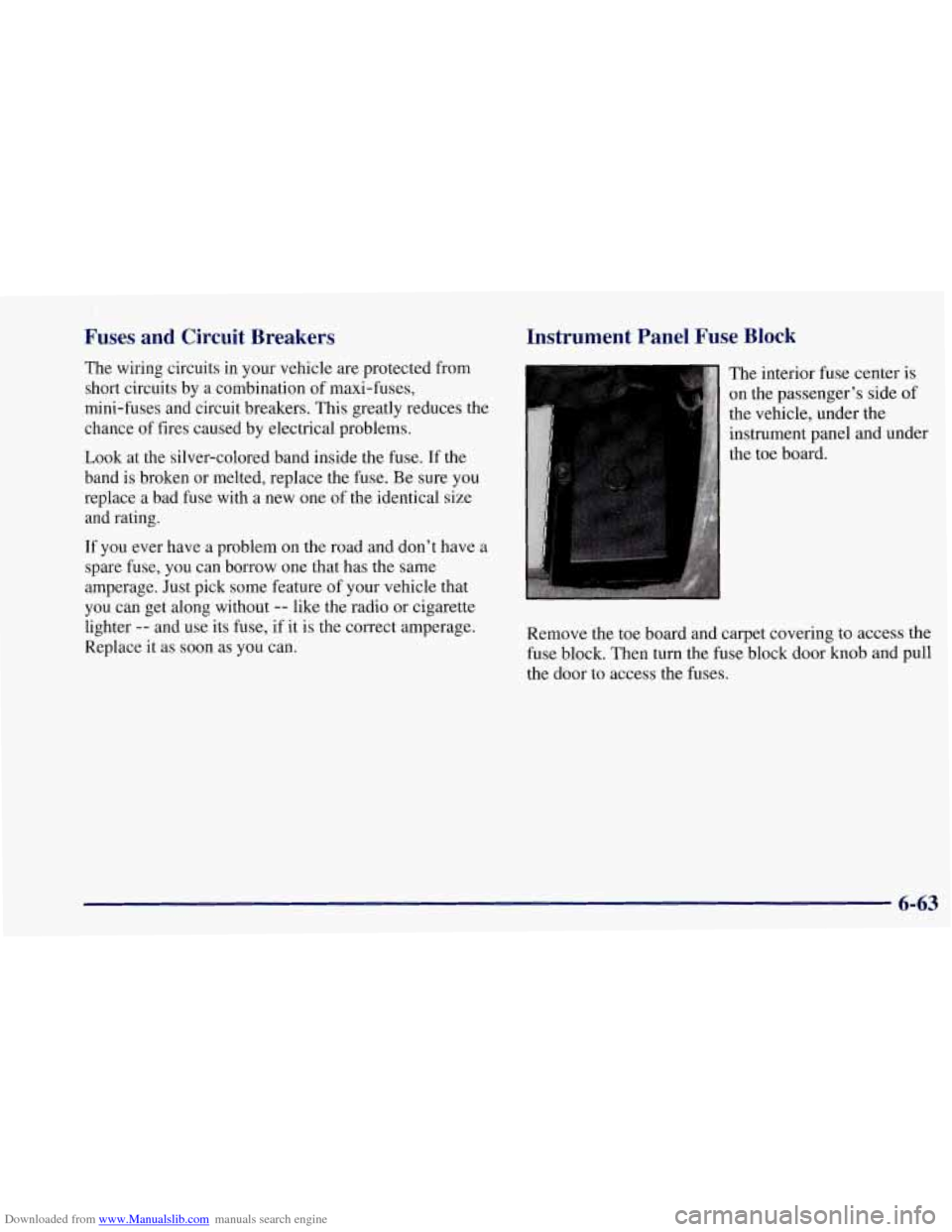1997 CHEVROLET CORVETTE wiring
[x] Cancel search: wiringPage 64 of 356

Downloaded from www.Manualslib.com manuals search engine It ca-- 3e dangerous to drive with the hatch open
because carbon monoxide
(CO) gas can come into
your vehicle. You can’t see or smell
CO. It can
cause unconsciousness and even death.
If you must drive with the hatch open or if
electrical wiring or other cable connections
must pass through the seal between the body
and the hatch:
0 Make sure all windows are shut.
Turn the fan on your heating or cooling
system to its highest speed with the setting
on BI-LEVEL or VENT. That will force
outside air into your vehicle. See “Comfort
Controls” in the Index.
instrument panel, open them all the way.
0 If you have air outlets on or under the
See “Engine Exhaust” in the Index.
NOTICE:
If you put things in the hatch area, be sure they
won’t break the glass when you close it.
Never slam the hatch down. You could break the
glass or damage the defogger grid.
When you close the hatch, make sure you pull
down from the center, not the sides.
If you pull
the hatch down from the side too often, the
weatherstrip can be damaged.
Theft
Vehicle theft is big business, especially in some cities.
Although your Corvette has a number of theft-deterrent
features, we know that nothing
we put on it can make
it impossible to steal. However, there are ways you
can help.
2-15
Page 106 of 356

Downloaded from www.Manualslib.com manuals search engine NOTICE:
If your Corvette has a compact disc player, it is
stored in the center rear storage compartment.
To help avoid damage to the compact disc player,
do not store items such as liquids or sharp objects
that could puncture or cut the compact disc
player or wiring.
Convenience Net (Option)
Your vehicle may have a convenience net. You will see
it on the back wall of the rear area
of the vehicle.
Put small loads, like grocery bags, in the net. It can help
keep them from falling over during sharp turns or quick
starts and stops. The net is not for larger, heavier loads.
You can unhook the net and place it in one
of the rear
storage pockets when
you are not using it. A vinyl
storage bag has also been provided.
Ashtray and Cigarette Lighter
The ashtray is located on the instrument panel, next to
the lighter.
To use the ashtray, lift up on the bottom of
the door.
NOTICE:
Don’t put papers and other things that burn
into your ashtray.
If you do, cigarettes or other
smoking materials could set them on fire,
causing damage.
I NOTICE: I
Loose objects (such as paper clips) can lodge
behind and beneath the ashtray lid and prevent
movement
of the lid. Avoid putting small loose
objects near the ashtray.
2-57
Page 121 of 356

Downloaded from www.Manualslib.com manuals search engine I Safety Belt Reminder Light
When the key is turned to ON or START, a chime will
come on for about eight seconds to remind people to
fasten their safety belts, unless the driver’s safety belt
is already buckled.
The safety belt light
will also come
on and
stay on until the driver’s
belt is buckled.
Air Bag Readiness Light
There is an air bag readiness light on the instrument
panel, which shows a deployed air bag symbol. The
system checks the air bag’s electrical system for
malfunctions. The light tells you if there
is an electrical
problem. The system check includes the air bag sensors, the
air bag modules, the wiring and the diagnostic
module. For more information
on the air bag system,
see “Air Bag” in the Index.
This light will come on
when you start your engine,
and it will flash for a few
seconds. Then the light should
go out. This means
the system is ready.
If the air bag readiness light stays on after you
start the
engine or comes on when you are driving, your air bag
system may not work properly. Have your vehicle
serviced right away.
The air bag readiness light should flash for a few
seconds when you turn the ignition key to
ON. If the
light doesn’t come on then, have it fixed
so it will be
ready to warn you if there
is a problem.
2-72
Page 269 of 356

Downloaded from www.Manualslib.com manuals search engine 3.
4.
5.
Remove the screws on each side of the headlamp
bezel.
Open the hood.
To remove the bezel, pull the sides slightly outward
and
tilt the bezel forward. Pull the clip centered
above the lens outward. Be careful not to scratch
the paint.
6. Reach behind the lamp and turn the bulb to the
left
to remove it. Don’t touch the halogen bulbs.
The inner bulb is the high beam and the outer bulb
is the low beam.
7. Disconnect the desired bulb from the wiring harness.
8. Reverse the steps with a new bulb.
6-34
Page 297 of 356

Downloaded from www.Manualslib.com manuals search engine NOTICE:
When using the accessory plug:
0
0
0
0
DO NOT splice wires directly into the
vehicle electrical wire harness.
If done
incorrectly, splicing may cause damage to
your electrical system and would not be
covered by the vehicle’s warranty.
The maximum load of any electrical
equipment should not exceed
15 amps.
Be sure to turn off any electrical equipment
when not in use. Leaving electrical
equipment on for extended periods of time
can drain your battery.
DO NOT use this plug if the electrical
equipment requires frequent connecting
and disconnecting. This may cause
excessive wear on the accessory plug and
damage your electrical system and the
damage would not be covered by
your warranty.
Headlamps
The headlamp wiring is protected by a circuit breaker.
An electrical overload will cause the lamps to go on and
off, or in some cases to remain off. If this happens, have
your headlamp wiring checked right away.
Windshield Wipers
The windshield wiper motor is protected by a fuse and
an internal circuit breaker.
If the motor overheats due to
heavy snow, etc., the wiper will stop until the motor
cools. If the overload
is caused by some electrical
problem and not snow, etc., be sure to get
it fixed.
Power Windows and Other Power Options
Circuit breakers protect the power seats and other power
accessories. When the current load is too heavy, the
circuit breaker opens and closes, protecting the circuit
until the problem is fixed or goes away.
6-62
Page 298 of 356

Downloaded from www.Manualslib.com manuals search engine Fuses and Circuit Breakers
The wiring circuits in your vehicle are protected from
short circuits by a combination of maxi-fuses,
mini-fuses and circuit breakers. This greatly reduces the
chance of fires caused by electrical problems.
Look at the silver-colored band inside the fuse. If the
band is broken or melted, replace the fuse. Be sure you
replace a bad fuse with a new one of the identical size
and rating.
If you ever have a problem on the road and don’t have a
spare fuse, you can borrow one that has the same
amperage. Just pick some feature of your vehicle that
you can get along without
-- like the radio or cigarette
lighter
-- and use its fuse, if it is the correct amperage.
Replace it as soon as you can.
Instrument Panel Fuse Block
The interior fuse center is
on the passenger’s side of
the vehicle, under the
instrument panel and under
the toe board.
Remove the toe board and carpet covering
to access the
fuse block. Then turn the fuse block door
knob and pull
the door to access the fuses.
6-63
Page 348 of 356

Downloaded from www.Manualslib.com manuals search engine Fiberglass Springs .............................. 6-58
Fifth Gear. Manual Transmission
................... 2-29
Filling Your Tank
................................ 6-5
Filter. Air Cleaner
.............................. 6- 16
Finish Care
.................................... 6-56
Finish Damage
................................. 6-57
First Gear. Automatic Transmission
................ 2-28
First Gear. Manual Transmission
................... 2-29
Flashers. Hazard Warning
......................... 5-2
Flat Tire. What to
Do ............................ 5-22
Floor Mats
.................................... 2-60
Fluid Capacities
................................ 6-70
FobTraining
................................... 2-89
Foreign Countries, Fuel
........................... 6-5
Fourth Gear. Manual Transmission
................. 2-29
French Language Manual
11
Front Sidemarker Lamp Bulb Replacement ........... 6-35
Front Turn Signal Lamp Bulb Replacement
.......... 6-35
Fuel
.......................................... 6-3
Canada
...................................... 6-4
In Foreign Countries
........................... 6-5
Fuel. Filling Your Tank
........................... 6-5
Fuses and Circuit Breakers
....................... 6-63
Gages
FogLamps
.................................... 2-51
.. ...........................
FrontTowing .................................. 5-10
Gage ....................................... 2-80
Engine Coolant Temperature
.................... 2-75
Engine Oil Pressure
........................... 2-78
Fuel
....................................... 2-81
Voltmeter
................................... 2-73 GAWR
.................................. 4.30. 4.31
Gear Positions
................................. 2-26
Gross Axle Weight Rating
................... 4.30. 4.31
Gross Vehicle Weight Rating
................. 4.30. 4-31
Guide en Franpis
11
GVWR .................................. 4.30. 4.31
Halogen Bulbs
................................ 6-33
Hazard Warning Flashers
.......................... 5-2
Headlamp Doors
............................... 2-44
Headlamp/Highbeams Bulb Replacement
............ 6-33
Headlamps
.................................... 2-43
Wiring
..........................................
Hearing Impaired, Customer Assistance .............. 8-4
Heating
....................................... 3-12
High-Beam Lamps
.............................. 2-45
Highway Hypnosis
............ ............... 4-24
Hill and Mountain Roads
..... ............. 4-24
Hood
Checking Things Under
...... .............. 6-8
Release
.................................... 6-8
Horn
......................................... 2-40
Hydraulic Clutch
............................... 6-20
Hydroplaning
.......................... ... 4-20
.. .................................
HighLow Beamchanger ...................... 2-45
Heritage Pages
111 ... ...................................
Ignition Switch .............. ............... 2-20
Inadvertent Load Control
....... ............... 2-53
Inflation. Tire
.................................. 6-43
Inside Daymight Rearview Mirror
................. 2-53
9-5
Page 354 of 356

Downloaded from www.Manualslib.com manuals search engine warning Devices ............................... 5-2
Warning Lights. Gages and Messages
............... 2-71
Warranty Information
............................ 8-10
Washer Fluid. Windshield
........................ 6-27
Washing Your Vehicle
........................... 6-55
Weatherstrips
.................................. 6-55
Wheel Alignment
.................................. 6-47
NutTorque
.................................. 6-70
Replacement
................................. 6-48
Using the Wheel Lock Key
..................... 6-50
Windows
..................................... 2-39
Express-Down
............................... 2-40
Power
...................................... 2-39 Windshield Washer
............................. 2-46
Fluid
....................................... 6-27
Fluid Level Check
............................ 7-13
Windshield Wipers
.............................. 2-45
Blade Replacement
........................... 6-37
Fuses
...................................... 6-62
Winter Driving
................................. 4-26
Wiper Blade Check
............................. 7-13
Wiring. Headlamp
.............................. 6-62
WreckerTowing
................................. 5-8
9-11